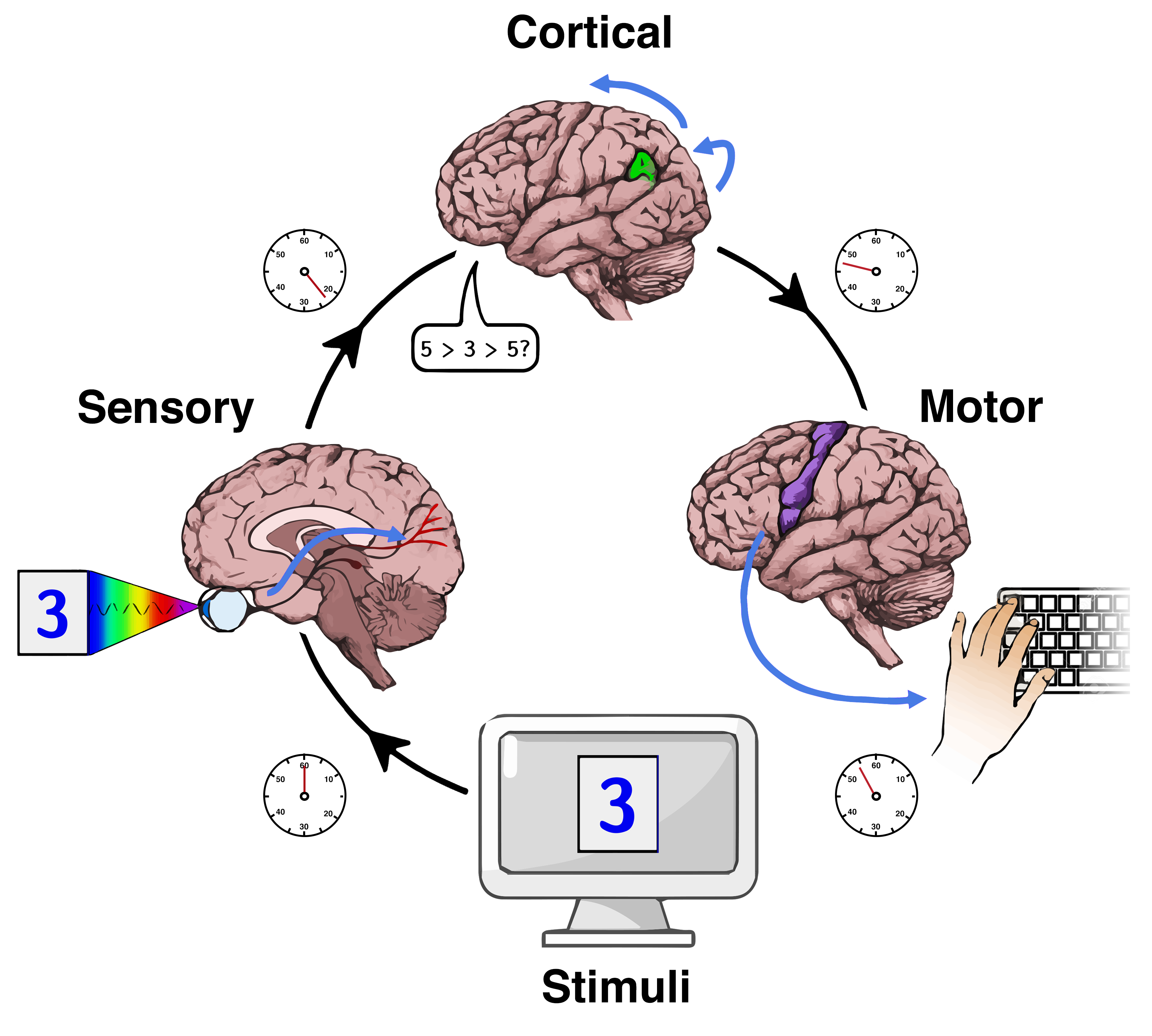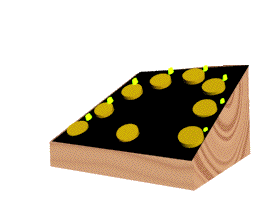|
Jensen Box
The Jensen box was developed by University of California, Berkeley psychologist Arthur Jensen as an experimental apparatus for measuring choice reaction time (RT) and individual differences in intelligence. Design and measurement The standard Jensen box is approximately 12 by 20 inches in size with a sloping face. Eight buttons are arrayed in a semicircle with a 'home' key in the lower center. Above each response button is a small LED light. Following an auditory warning tone and a delay, one of the lights is illuminated and the participant releases their finger from the home button. Participants then move to initiate a button press at the illuminated location as quickly as possible. RT is measured in two different ways: the time elapsed between the light signal and the home button release, and the time between the home button release and the target button press. These separate measures were initially conceptualized as assessing "decision time" and "movement time," respectively. ... [...More Info...] [...Related Items...] OR: [Wikipedia] [Google] [Baidu] |
Jensen Box
The Jensen box was developed by University of California, Berkeley psychologist Arthur Jensen as an experimental apparatus for measuring choice reaction time (RT) and individual differences in intelligence. Design and measurement The standard Jensen box is approximately 12 by 20 inches in size with a sloping face. Eight buttons are arrayed in a semicircle with a 'home' key in the lower center. Above each response button is a small LED light. Following an auditory warning tone and a delay, one of the lights is illuminated and the participant releases their finger from the home button. Participants then move to initiate a button press at the illuminated location as quickly as possible. RT is measured in two different ways: the time elapsed between the light signal and the home button release, and the time between the home button release and the target button press. These separate measures were initially conceptualized as assessing "decision time" and "movement time," respectively. ... [...More Info...] [...Related Items...] OR: [Wikipedia] [Google] [Baidu] |
Standard Deviation
In statistics, the standard deviation is a measure of the amount of variation or dispersion of a set of values. A low standard deviation indicates that the values tend to be close to the mean (also called the expected value) of the set, while a high standard deviation indicates that the values are spread out over a wider range. Standard deviation may be abbreviated SD, and is most commonly represented in mathematical texts and equations by the lower case Greek letter σ (sigma), for the population standard deviation, or the Latin letter '' s'', for the sample standard deviation. The standard deviation of a random variable, sample, statistical population, data set, or probability distribution is the square root of its variance. It is algebraically simpler, though in practice less robust, than the average absolute deviation. A useful property of the standard deviation is that, unlike the variance, it is expressed in the same unit as the data. The standard deviation of a popu ... [...More Info...] [...Related Items...] OR: [Wikipedia] [Google] [Baidu] |
Mental Chronometry
Mental chronometry is the scientific study of processing speed or reaction time on cognitive tasks to infer the content, duration, and temporal sequencing of mental operations. Reaction time (RT; sometimes referred to as "response time") is measured by the elapsed time between stimulus onset and an individual's response on elementary cognitive tasks (ETCs), which are relatively simple perceptual-motor tasks typically administered in a laboratory setting. Mental chronometry is one of the core methodological paradigms of human experimental psychology, experimental, cognitive psychology, cognitive, and differential psychology, but is also commonly analyzed in Physiological psychology, psychophysiology, cognitive neuroscience, and behavioral neuroscience to help elucidate the biological mechanisms underlying perception, attention, and decision-making in humans and other species. Mental chronometry uses measurements of elapsed time between sensory stimulus onsets and subsequent behavi ... [...More Info...] [...Related Items...] OR: [Wikipedia] [Google] [Baidu] |
Inspection Time
Inspection time refers to the exposure duration required for a human subject to reliably identify a simple stimulus. Typically a stimulus made up of two parallel lines differing in length and joined at the tops by a cross bar is presented (similar to the Greek letter Pi). The ability to quickly detect the identity of a stimulus is moderately heritable and correlates with the subject's IQ. Overview If asked which of the two lines in the figure below is longer; the left or the right, almost all non-visually impaired subjects can answer correctly 100% of the time. If, however, the stimulus is backward masked after a short period of time, the proportion of correct responses declines as the exposure duration reduces, and reliable individual differences emerge in the percent identified correctly at different intervals. The task itself was proposed by Doug Vickers as a measure of the rate of accumulation of information. Ted Nettelbeck, Chris Brand and others demonstrated it related ... [...More Info...] [...Related Items...] OR: [Wikipedia] [Google] [Baidu] |
Intelligence
Intelligence has been defined in many ways: the capacity for abstraction, logic, understanding, self-awareness, learning, emotional knowledge, reasoning, planning, creativity, critical thinking, and problem-solving. More generally, it can be described as the ability to perceive or infer information, and to retain it as knowledge to be applied towards adaptive behaviors within an environment or context. Intelligence is most often studied in humans but has also been observed in both non-human animals and in plants despite controversy as to whether some of these forms of life exhibit intelligence. Intelligence in computers or other machines is called artificial intelligence. Etymology The word ''intelligence'' derives from the Latin nouns '' intelligentia'' or '' intellēctus'', which in turn stem from the verb '' intelligere'', to comprehend or perceive. In the Middle Ages, the word ''intellectus'' became the scholarly technical term for understanding, and a translation f ... [...More Info...] [...Related Items...] OR: [Wikipedia] [Google] [Baidu] |
Odd Man Out Test
The Odd-Man-Out Reaction Time test (OMO RT) is a test of reaction times that uses Arthur Jensen's testing apparatus, the Jensen box. The box is normally used for measuring choice reaction times in which the participant in the experiment is tested on their ability to recognize which of the eight lights of the Jensen box is illuminated, as quickly as possible. However, in the Odd Man Out Reaction Time test, three lights are illuminated in each trial. Two are close together and the other further apart; the individual being tested must identify this third light. The Odd-Man-Out Reaction Time test correlates with " Intelligent Quotients (IQ) in the range of 0.30 to 0.60, a reliable and substantial effect." This correlation range is typically higher than the correlations to IQ in other reaction-time tests. Experiments In 1986, Frearson and Hans Eysenck conducted an experiment in which they assessed participants on various intelligence tests including Jensen's Choice Reaction Time , I ... [...More Info...] [...Related Items...] OR: [Wikipedia] [Google] [Baidu] |
Correlations
In statistics, correlation or dependence is any statistical relationship, whether causal or not, between two random variable A random variable (also called random quantity, aleatory variable, or stochastic variable) is a mathematical formalization of a quantity or object which depends on random events. It is a mapping or a function from possible outcomes (e.g., the po ...s or bivariate data. Although in the broadest sense, "correlation" may indicate any type of association, in statistics it usually refers to the degree to which a pair of variables are ''line (geometry), linearly'' related. Familiar examples of dependent phenomena include the correlation between the human height, height of parents and their offspring, and the correlation between the price of a good and the quantity the consumers are willing to purchase, as it is depicted in the so-called demand curve. Correlations are useful because they can indicate a predictive relationship that can be exploited in pract ... [...More Info...] [...Related Items...] OR: [Wikipedia] [Google] [Baidu] |
Cohort Study
A cohort study is a particular form of longitudinal study that samples a cohort (a group of people who share a defining characteristic, typically those who experienced a common event in a selected period, such as birth or graduation), performing a cross-section at intervals through time. It is a type of panel study where the individuals in the panel share a common characteristic. Cohort studies represent one of the fundamental designs of epidemiology which are used in research in the fields of medicine, pharmacy, nursing, psychology, social science, and in any field reliant on 'difficult to reach' answers that are based on evidence (statistics). In medicine for instance, while clinical trials are used primarily for assessing the safety of newly developed pharmaceuticals before they are approved for sale, epidemiological analysis on how risk factors affect the incidence of diseases is often used to identify the causes of diseases in the first place, and to help provide pre-clinica ... [...More Info...] [...Related Items...] OR: [Wikipedia] [Google] [Baidu] |
Ian Deary
Ian John Deary OBE, FBA, FRSE, FMedSci (born 1954) is a Scottish psychiatrist known for work in the fields of intelligence, cognitive ageing, cognitive epidemiology, and personality. Deary is Professor of Differential Psychology at The University of Edinburgh. He is former Director of the Centre for Cognitive Ageing and Cognitive Epidemiology and co-Director of the Alzheimer Scotland Dementia Research Centre. Research Ian Deary has contributed to numerous topics in intelligence research. For instance, he has conducted several studies into the relationship between intelligence and elementary cognitive tasks such as reaction time and inspection time, and has investigated the overlap between intelligence and educational achievement. In 1983 he obtained a PhD at the University of Edinburgh with the thesis "Social work and the elderly: a problem of definition" written for the Stuart Macgregor Memorial Prize. Deary was a founder of the field of cognitive epidemiology, which s ... [...More Info...] [...Related Items...] OR: [Wikipedia] [Google] [Baidu] |
Quarterly Journal Of Experimental Psychology
The Experimental Psychology Society (EPS) is an academic society which facilitates research into experimental psychology and communication between experimental psychologists. It is based in the United Kingdom. The society was originally formed as the "Experimental Psychology Group" by Oliver L. Zangwill in 1946. The first meeting was held in the rooms of Professor Frederic Bartlett, in St. John's College, Cambridge. EPS in co-operation with The British Psychological Society published guidelines for members engaged psychological activities involving living animals. The Group became the EPS in 1958, the transition being handled by the then president, W. E. Hick William Edmund Hick (1 August 1912 – 20 December 1974) was a British psychologist, who was a pioneer in the new sciences of experimental psychology and ergonomics in the mid-20th century. Hick trained as a medical doctor, taking the MB a .... The society publishes ''The Quarterly Journal of Experimental Psychol ... [...More Info...] [...Related Items...] OR: [Wikipedia] [Google] [Baidu] |
Variance
In probability theory and statistics, variance is the expectation of the squared deviation of a random variable from its population mean or sample mean. Variance is a measure of dispersion, meaning it is a measure of how far a set of numbers is spread out from their average value. Variance has a central role in statistics, where some ideas that use it include descriptive statistics, statistical inference, hypothesis testing, goodness of fit, and Monte Carlo sampling. Variance is an important tool in the sciences, where statistical analysis of data is common. The variance is the square of the standard deviation, the second central moment of a distribution, and the covariance of the random variable with itself, and it is often represented by \sigma^2, s^2, \operatorname(X), V(X), or \mathbb(X). An advantage of variance as a measure of dispersion is that it is more amenable to algebraic manipulation than other measures of dispersion such as the expected absolute deviation; for e ... [...More Info...] [...Related Items...] OR: [Wikipedia] [Google] [Baidu] |


